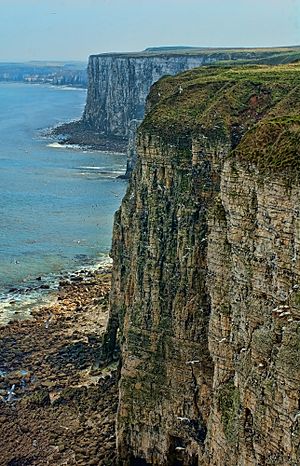Bempton Cliffs facts for kids
Quick facts for kids Bempton Cliffs |
|
|---|---|

Bempton Cliffs looking towards Flamborough Head
|
|
| Location | East Riding of Yorkshire, England |
| OS grid | TA201738 |
| Coordinates | 54°08′46″N 0°09′37″W / 54.146111°N 0.160278°W |
Bempton Cliffs is an amazing place on the coast in East Riding of Yorkshire, England. It's famous for its tall cliffs and the thousands of seabirds that come here to nest. The RSPB (Royal Society for the Protection of Birds) looks after this special nature reserve. You can see many different birds like gannets, puffins, razorbills, guillemots, kittiwakes, and fulmars. There's even a visitor centre to help you learn more!
Contents
Exploring Bempton Cliffs
The cliffs at Bempton are made of strong chalk. This means they don't wear away easily from the sea and wind. This makes them perfect for birds to build their nests in the many sheltered spots and cracks.
Where are the Cliffs?
The cliffs stretch for about 6 miles (10 km) from Flamborough Head up towards Filey. At some points, they are over 328 feet (100 metres) high! These are some of the highest chalk cliffs in England. For comparison, Beachy Head in East Sussex is the highest at 530 feet. The RSPB also looks after the nearby Buckton Cliffs.
Visitor Experience
There are good walkways along the top of the cliffs. You'll find several safe viewing points with fences. These spots let you get a great look at the birds without disturbing them.
Amazing Seabirds of Bempton Cliffs
Bempton Cliffs is a very important home for many seabirds. It's one of the best places in the UK to see them up close.
Gannets: England's Only Mainland Colony
Bempton Cliffs is the only place on the mainland of England where gannets come to breed. These large, beautiful birds start arriving at the cliffs in January. They stay until August or September before heading out to sea again.
Kittiwakes: A Huge Population
The kittiwake is the most common bird you'll see here. About 10% of all the kittiwakes in the United Kingdom nest at Bempton Cliffs. They are a type of gull, but they are smaller and more graceful.
Puffins: A Special Nesting Spot
The puffins at Bempton Cliffs are quite special. Unlike most places in the UK where puffins dig burrows, the Bempton puffins tend to nest in cracks in the rocks. It can be a bit tricky to spot them closely, even though there are around 958 birds (about 450 breeding pairs). Sadly, the puffins along the Yorkshire coast are now considered endangered.
Most of the Bempton puffins fly about 25 miles (40 km) east to the Dogger Bank to find food. Their numbers might be affected by fewer sand eels in the area. This could be due to global warming, which is causing the sea temperature to rise by about 2 degrees. This temperature change might be pushing the tiny sea creatures (plankton) that sand eels eat further north.


